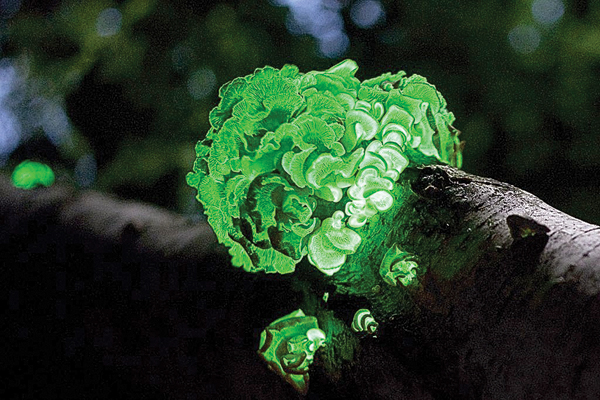
Melondy Phllips
Staff Writer
Fairy Fire
Imagine living long ago and taking a relaxing night stroll through the woods. You are enjoying the stillness of the night air and the harmonious sounds of the night insects when you catch a glimpse of an unexpected light nearby. It’s too small to be someone’s fire. Maybe it’s someone’s lantern. Could it be the moon’s reflection in a predator’s eyes?
The thought ‘am I being hunted” flashes through your mind and you freeze. What could it be?
Your heart starts to pound as you slowly turn to examine this in greater detail. As you perceive this curious sight, your heart slows and curiosity takes hold. Carefully inching closer, you identify this light, not as a reflection, but a glow.
How can this be?
A fire light without heat?
The existence of foxfire, fairy fire, has not always been common knowledge.
The oldest recorded documentation of foxfire is from 382 B.C. when Aristotle referred to it as a cold fire; however the cause of the eye-catching illumination wasn’t discovered until 1823. Samples of wooden support beams from mines were studied and revealed that the glow came from fungal growth.
Sarah Fesmire, in her article for the University of Chicago Library news, posted March 21, 2015, https://www.lib.uchicago.edu/about/news/foxfire-and-fungi-solving-a-2300-year-old-mystery/, stated, “Currently, 71 different species of fungi have been identified as bioluminescent (capable of glowing in the dark), but scientists are still puzzling over the exact chemical properties that enable this bioluminescence.” This number increased to 75 species as of 2020 and has now expanded to 80.
The oxidative enzyme Luciferase reacts with luciferin within the fungus as the quick growing cells feed on decaying hardwood. The resulting bioluminescence produced is affirmation of the fungus growth. The bioluminescence can remain for up to 50 hours after a healthy fungus has been clipped from its food source.
Foxfire can be found in damp, never dry, dead wood forests throughout Asia, Australia, Europe and North America. The ideal temperature for active bioluminescence activity ranges from about 40 degrees to around 77 degrees Fahrenheit. Once temperatures rise above the mid 80s, the bioluminescence shut down.
Although I was not able to locate any official reported sightings, many folks have happily discussed seeing Jack O’ Lantern and Armillaria mycelium mushrooms aglow throughout West Virginia in recent years. Could there be more?
Hunting for foxfire can be treacherous. Any light can interfere with the ability to perceive the subtle glow of most species of foxfire. Some species can be more readily seen while others produce bioluminescence so dim that it is hard to see with the naked eye. Needing a night, void of all light, enhances the possibility of encountering one of many nocturnal forest critters and predators while looking for foxfire. Learning to recognize what they look like during the day will greatly increase your chances of spotting them at night.
If you do happen across this elusive spectacle let it keep growing or use sustainable harvesting practices so generations to come can also enjoy them.
Contact the WVDNR at https://wvdnr.gov/plants-animals/ or 304-558-6200 about sightings so they can track its growth.
With about 80 different species, let’s see how many we can find.


